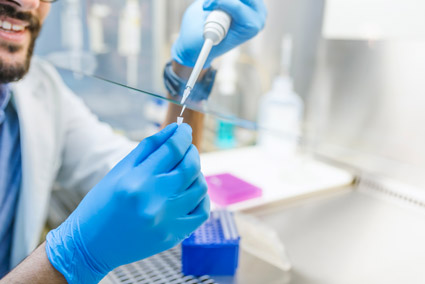Hybridization capture
Overview
Hybridization capture is a targeted next generation sequencing method that uses long, biotinylated oligonucleotide baits (probes) to hybridize to the regions of interest. It is particularly helpful when genotyping, rare variants, and exome sequencing.
What is hybridization capture (target enrichment)?
Hybridization capture, also called target enrichment, is one method of targeted next generation sequencing (other methods include the use of amplicons or molecular inversion probes). Before performing hybridization capture, DNA samples are converted into sequencing libraries—a process that involves random shearing of DNA and ligation of sequencing adaptors to the ends of the resulting fragments (PCR amplification may or may not be required). Regions of interest within the library are then captured using long, biotinylated oligonucleotide baits (probes).
Biotinylated baits are designed to hybridize to regions of interest (e.g., exome, known genes related to cancer or a metabolic pathway, etc.). After bait hybridization, separation occurs via magnet with the streptavidin-biotin binding complex.
Baits can be arranged in different ways to sequence regions of interest. For example:
- Tiling baits allows large contiguous regions to be covered end to end.
- Overlapping baits permits extra sequencing to occur at the ends of targets to ensure that no part of the sequence is missed.
Baits can also be positioned to overcome challenging motifs such as repetitive sequences. Because the DNA is randomly sheared during library preparation, the captured fragments are overlapping and unique.
When to use hybridization capture
Because hybridization capture focuses on specific genomic regions of interest, it is a cost-effective and sequencing effort-saving approach.
Another major advantage is the multiplexing capacity of hybridization capture. Indexes (molecular barcodes) are ligated to DNA samples, so samples can be combined either before or after enrichment. Pre-capture multiplexing is advantageous for pooling several samples at equal mass into one sample (Figure 1). Although multiplexing increases your efficiency, it is necessary to add more probes.
Additional advantages of hybridization capture include:
- Maximizes on-target reads and aligned reads
- Does not require PCR primer design
- Higher accuracy for mutations
- Superior performance with complex sequences
Hybridization capture can be used for several different applications, including:
- Genotyping
- Gene discovery
- Rare variant
- Indel
- Copy number variation
- Exome sequencing
The beneficial characteristics and wide applicability of hybridization capture make it a particularly attractive choice for researchers in several areas, including:
- Cancer research
- Rare diseases research
- Infectious disease research/targeted pathogen
- Environmental research applications
- Microbiome research
xGen Exome Research Panel v2 white paper
Learn how our large-scale production platform, using PCR-free synthesis, provides a unique advantage over array-based platforms by delivering consistent exome panel performance over time.
Improving accuracy with unique molecular identifiers
For sequencing runs that require additional sequencing precision, adapters with unique molecular identifiers (UMIs) can be used with hybridization capture. UMIs are like indexes in that they facilitate identification of specific molecules within a sample. They can be used to remove duplicates generated during PCR that may create a bias. This is particularly helpful for providing more accurate quantification of true coverage in a region because of more accurate deduplication. UMIs can also be used for error correction to remove PCR and sequencing errors, which is particularly important for low-frequency variant. By removing errors, you can increase variant accuracy while significantly minimizing false positives.
Combining NGS technologies for biomarker identification and confirmation research application note
IDT has developed 2 unique, high-performing targeted NGS approaches to maximize researchers’ ability to confidently identify and confirm biomarkers in germline and somatic mutations. Here, we describe the benefits and caveats of using either hybridization capture or amplicon sequencing to identify mutations in normal tissue, formalin-fixed, paraffin-embedded (FFPE) tumor, and cell-free DNA (cfDNA).
Get started with hybridization capture
IDT offers a suite of pre-designed xGen hybridization capture panels for targeted next generation sequencing research. Choose from eight different panels including the Exome Hyb Panel v2, AML Cancer Hyb Panel, SARS-CoV-2 Hyb Panel, and the Inherited Diseases Panel. Don’t have what you’re looking for? No problem. IDT can also help you design custom hybridization capture probes for your specific research applications. Contact us today to learn more about getting started with hybridization capture.
Explore hybridization capture resources
RUO22-1130_001

